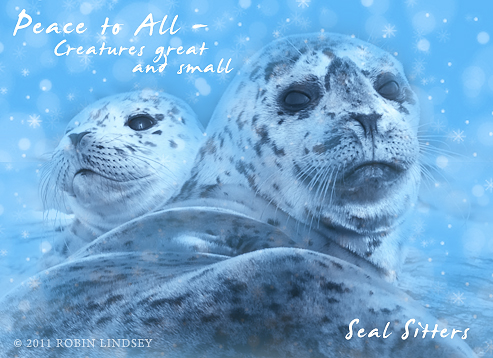Dec 2011
2011 a record breaking year for Seal Sitters
Dec/31/11 10:09 PM
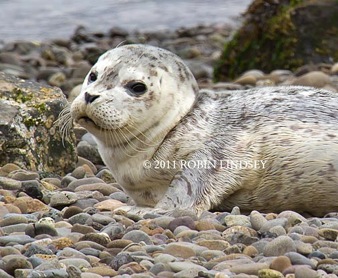
THE STATS
This was a record breaking season for seal pups on shore. In 2011, Seal Sitters’ hotline fielded 724 calls from all over the Puget Sound region. Pupping season in South Puget Sound is late June - September, but our busiest months are September and October as pups leave the rookeries and strike out on their own. In those two months alone, the hotline handled 377 reports. Our West Seattle volunteers have logged over 150 responses to seal pups, looking after 51 different pups - a number of whom hauled out repeatedly for many days in a row (including Blanco shown above). Seal pup Spanky was a fixture on the rocks along Alki Beach, using the shoreline almost daily for two months, but had to be rescued twice from entrapment in the rocks. View a map that shows our West Seattle responses from August - December. And our Sno-King volunteers made numerous responses to marine mammals from the Seattle waterfront as far north as Tulalip. We had two unusual visitors to West Seattle and Ballard’s Golden Gardens: molting elephant seals. Seal Sitters’ investigators participated in the necropsy of the gray whale that died in Bremerton, as well as that of an adult female seal who had recently given birth in West Seattle (suspected to have been Tiny’s mom).
MEDIA
Seal pups Peaches and Sly became media celebrities in Associated Press and Seattle Times articles about our landmark season. The West Seattle Blog provided on-going reports of our activities. As is true each season, we had local TV coverage as well. The recent story of Frosty’s death was picked up by CNN to distribute internationally. WSDOT featured us on the homepage of the Washington State Ferries website.
PROJECTS
Seal Sitters received a second City of Seattle Department of Neighborhoods in-kind grant award this year. As a result, a number of high-visibility projects were completed:
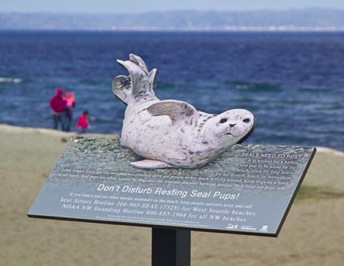
• Share the Shore public service announcement. A 30 second video spot about harbor seal pups’ need to rest onshore was created and broadcast on major TV networks across Puget Sound.
• Share the Shore informational brochures. Over 5,000 pocket-sized brochures with info about the stranding network and seal pups were distributed at street fairs, outreach events and on the beach.
• Share the Shore street banners. 10 colorful banners with an illustration of a seal pup and the message “Share the Shore” were hung from light poles along Alki Beach during the months of September and October.
COMMUNITY OUTREACH
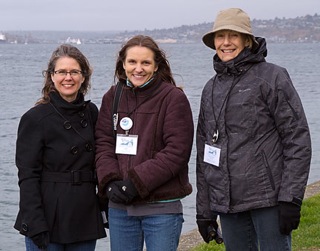
• We participated in a number of street fairs, including the Ballard Seafood Fest and Alki Art Fair, educating scores of people about marine mammals and NOAA’s NW stranding network.
• Seal Sitters co-sponsored two beach cleanups with the Alki Community Council, receiving TV coverage and raising awareness about marine debris.
• Volunteers made presentations at schools and participated in the Seattle Aquarium’s Marine Mammal Mania.
• Five training sessions (lecture and on-the-beach) were held for new volunteers in 2011.
Thanks to all our amazing volunteers and to the community for making this such a successful year. If you’d like to help support Seal Sitters’ work with a donation, please click here. We receive no funding for our on-going expenses and even the smallest amount helps defray the cost of our dedicated hotline, websites and supplies. We wish everyone a peaceful and happy new year.
Frosty's death a harsh reality for weaned pups
Dec/30/11 07:47 AM

Around 9pm Saturday night, the hotline received a call of a pup “sleeping peacefully” on the beach. Our responder instead found a dead pup. There, in the darkness, we examined both the pup and the area surrounding him. There were no human footprints or animal tracks to indicate foul play or the presence of a predator nor any obvious cause of death. By the beam of the flashlight, our investigator was saddened by the realization that it was most likely Frosty, who had distinctive markings under his eyes (photo comparisons late that night confirmed the identity). We could see his haulout tracks leading a distance up from the water’s edge to the rocks below the sea wall and his return tracks halfway back to the Sound where he died.
Frosty’s body was delivered to the WDFW Marine Mammal Investigations Unit early Christmas morning for necropsy. Many thanks to volunteer Theresa for making that long, sad drive on a holiday. The subsequent necropsy revealed that Frosty had been foraging very successfully, with a belly of fish bones and parts, and was in fair body condition. However, his lungs and trachea were filled with lungworms and he had pneumonia complicated by a bacterial infection. The biologist was amazed that he had been able to continue to dive and catch fish with such limited lung capacity.
So, why is it that weaned pups are so much more at risk for parasite loads and infection than adult seals? As Dyanna Lambourn, WDFW marine mammal biologist explains, a nursing pup gains temporary or “passive” immunity from mom’s milk which contains a high density of white blood cells. While nursing, if that pup is exposed to a parasite or virus, his body will begin to develop its own antibodies - all the while being stimulated and reinforced by mom’s immunity. Once weaned, however, the pup’s immune system no longer has that support and quickly becomes suppressed. If the now vulnerable pup is exposed to a new worm or virus, he may not be able to build antibodies quickly enough to fight it off or the accompanying complications. As Dyanna says, it is similar to sending your child off to kindergarten, where suddenly she is exposed to a myriad of new “bugs.” But pups weaned at only 4-6 weeks don’t have mom’s milk and protection to nurse them back to health.
Weaned pups face extreme challenges. Learning to catch fish can be a daunting task. As they struggle to learn to forage on their own and become thinner, losing that layer of blubber that provides warmth and energy, opportunistic parasites and viruses can take hold. Contaminants in our polluted waters drastically compound the risk to weaned pups. Storm runoff contaminants, such as pcbs and flame retardants, enter the food chain and further weaken a pup’s already compromised immune system.
As we have stated many times in our public outreach, a seal pup has only a 50% chance of survival the first year. This is why it is so imperative that people allow them the best chance possible - by giving them space on shore to rest and warm up. This simple act can truly be the difference between life and death. The total number of dead pups in West Seattle since August has now reached 16 - while only 5 of those belonged to our database of the 50 pups we’ve watched over this season (Tiny, Bianca, Qayak, Aquarius and now, Frosty). This white little pup Frosty brought a tremendous amount of joy and awareness to all who watched over him this Christmas season.
Frosty the seal pup needs rest, not tuna fish
Dec/23/11 06:42 PM
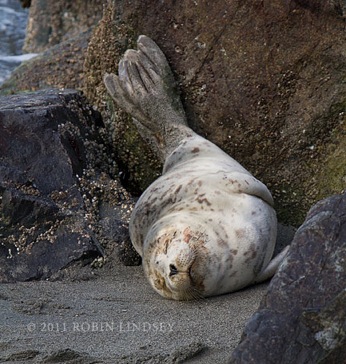
The person who tried to feed Frosty obviously had good intentions, but it was very misguided. Instead of helping Frosty, it only put him at risk. And that person was at risk as well. Pups can inflict a very serious wound and can transmit disease. Additionally, the food might have attracted another animal, such as a raccoon or coyote, which could have led to injury of either or both animals. We want to remind everyone that it is ILLEGAL to disturb in any way a resting marine mammal. Attempting to touch, move or feed a seal is a violation of Federal law - the Marine Mammal Protection Act. The best thing anyone can do for seal pups is to let them get the rest which is critical to their survival and please call our hotline @ 905-7325 (SEAL).
Milestone pup #50 visits West Seattle
Dec/22/11 06:43 PM

Spanky and friends still using the shore
Dec/12/11 08:18 AM

Volunteers also responded to two pups at Lincoln Park this past week. As long as there is a food source to support the now-weaned pups, they will continue to seek rest on shore. Please stay alert as you walk the beaches of Puget Sound and make sure to give us a call if you come across a seal pup or other marine mammal.
Craggy rocks spell trouble again for Spanky
Dec/03/11 10:42 AM


We want to remind the public that only certain authorized personnel from the NW Marine Mammal Stranding Network are allowed to handle a seal pup. It is a violation of the Marine Mammal Protection Act to touch, feed, move or otherwise disturb a seal. It can also be a dangerous endeavor as these are wild animals capable of inflicting a serious bite. If you see Spanky along the sea wall, please remember to keep your distance for his safety and call Seal Sitters. This little one seems to have a penchant for trouble and we want to keep him safe and healthy.
